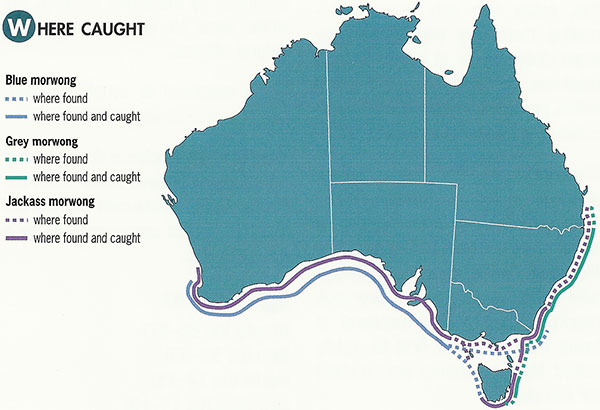Catch limits
| Catch limit | Fishing Mortality* | Biomass** |
|---|---|---|
Catch Limit (Incidental) 50 tonnes For the 2025–26 Season | R;Subject to overfishing | R;Overfished |
* Fishing mortality status relates to the level of fishing pressure on a stock – specifically, whether fishing mortality in the year being assessed is likely to result in the stock becoming overfished or prevent the stock from rebuilding from an overfished state. If fishing mortality exceeds either of these thresholds, a stock is considered to be subject to overfishing.
** Biomass status relates to how many fish there are – specifically, whether the biomass in the year being assessed is above the level at which the risk to the stock is considered to be unacceptable. The HSP defines this level as the limit reference point, below which the stock is considered to be overfished.
Scientific name: Nemadactylus macropterus
Family: Cheilodatylidae
Other names: Sea bream, jackass fish, perch, silver perch, squeeker perch, deepsea perch, mowie
Description: Jackass morwong are greyish silver on the upper body and silver white below. A broad grey to black ‘saddle’ extends across the back directly behind the head. The pectoral fins have a single long ray.
Size (length and weight): Up to 70 cm in length and 4.5 kg. Commonly found at 40‑60 cm in length and 0.9‑3 kg. Females grow faster and larger than males.
Life span: Usually up to 16 years. Females live longer than males. Can live up to about 40 years.
Habitat: Jackass morwong are a temperate demersal species that inhabits the continental shelf and upper slope. They can be found at depths of 10‑400 metres. Juveniles tend to live near shallow reefs. Jackass morwong have an extended pelagic post-larval stage known as ‘paperfish’, with metamorphosis into juveniles occurring after 9‑12 months. Feeding occurs at night.
Prey: Polychaete worms, crustaceans, molluscs and echinoderms.
Predators: Likely preyed on by predatory fish, sharks and marine mammals.
Reproduction: Jackass morwong reach reproductive maturity at 3 years of age. Spawning occurs multiple times from late summer to autumn. Females produce 0.1‑1 million eggs per spawning season depending on their body size.
Other notes: Known as teraki or terakihi in New Zealand.
| Fishery found in | Gear used | Catch of this species is targeted or incidental |
|---|---|---|
| Southern and Eastern Scalefish and Shark Fishery – Commonwealth Trawl Sector | Bottom trawl | Incidental |
| Southern and Eastern Scalefish and Shark Fishery – Gillnet Hook and Trap Sector | Gillnet | Incidental |
| Southern and Eastern Scalefish and Shark Fishery – Great Australian Bight Trawl Sector | Bottom trawl | Incidental |
The Commonwealth catch of jackass morwong is managed by quota. This means the catch of this fish by commercial fishers is restricted by weight.
Commercial fishermen are required to fill in records of their catches, during each fishing trip and when they land their catch in a port. This helps us keep records of how much is being caught.
Jackass morwong was assessed as overfished in 2021. Since then, AFMA has implemented management arrangements to reduce the total catch, including significantly reduced TACs, and from 1 May 2023 will implement a network of closures along the east coast aimed at constraining catches of at-risk species. A formal rebuilding strategy for jackass morwong will be developed during 2023.
Jackass morwong can also be caught in the High Seas area. Australian boats fishing for jackass morwong in this area are limited in how much they can catch and where they can fish. They must have a High Seas permit authorised by AFMA.
For more information about jackass morwong stock assessments, refer to the SESSF species summary.
Jackass morwong are distributed along the southern Australian coast including Tasmania.
Adults live close to the sea floor and are found on the continental shelf and upper slope in depths up to 450 metres.
They are most commonly caught at depths between 80 and 170 metres.

Bottom trawl is the main fishing method used to catch jackass morwong.
AFMA mitigates, or reduces, the impact bottom trawling may have on species and their habitats through its ecological risk management strategy. Management arrangements and strategies that aim to reduce the impact of fishing on the environment include:
- minimum mesh sizes for otter trawls to reduce the catch of small and juvenile fish
- mitigation devices to reduce interactions with threatened endangered and protected species
- closing some areas from fishing to protect vulnerable species and habitats.
Gear
Want to know more?
This is just an overview of jackass morwong, if you want to know more see the links below.
This fish is managed under the Southern and Eastern Scalefish and Shark Fishery and under the High Seas Fishery.